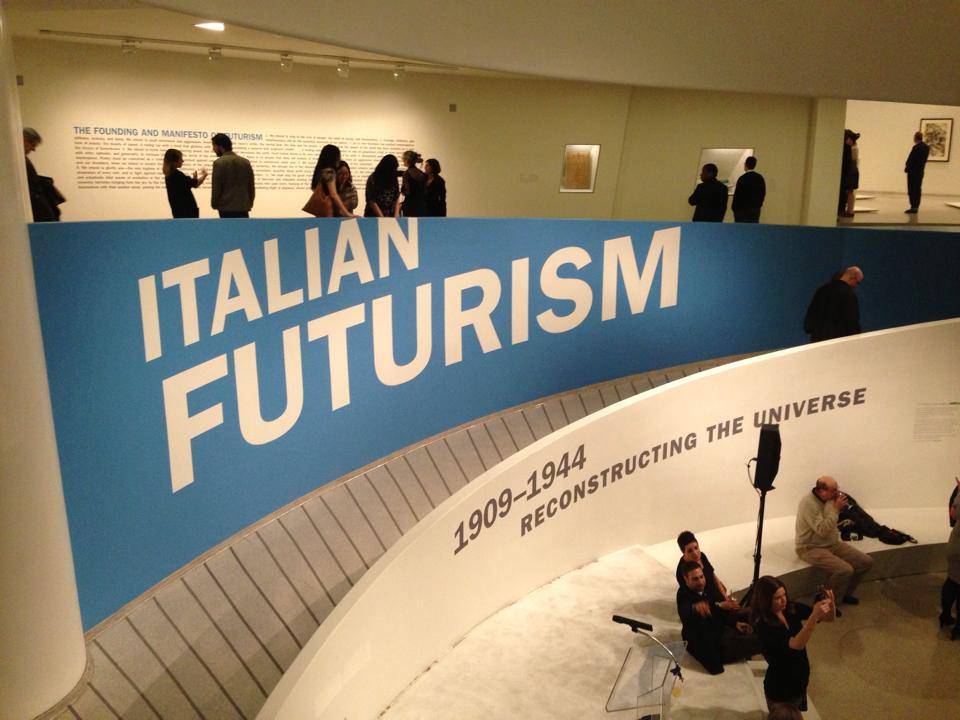Italian Futurism, 1909–1944: Reconstructing the Universe
Giovanni Acquaviva, Guillaume Apollinaire, Fedele Azari, Francesco Balilla Pratella, Giacomo Balla, Barbara (Olga Biglieri), Benedetta (Benedetta Cappa Marinetti), Mario Bellusi, Ottavio Berard, Romeo Bevilacqua, Piero Boccardi, Umberto Boccioni, Enrico Bona, Aroldo Bonzagni, Anton Giulio Bragaglia, Arturo Bragaglia, Alessandro Bruschetti, Paolo Buzzi, Mauro Camuzzi, Francesco Cangiullo, Pasqualino Cangiullo, Mario Carli, Carlo Carra, Mario Castagneri, Giannina Censi, Cesare Cerati, Mario Chiattone, Gilbert Clavel, Bruno Corra (Bruno Ginanni Corradini), Tullio Crali, Tullio d’Albisola (Tullio Mazzotti), Ferruccio Demanins, Fortunato Depero, Nicolaj Diulgheroff, Gerardo Dottori, Fillia (Luigi Colombo), Luciano Folgore (Omero Vecchi), Corrado Govoni, Virgilio Marchi, Filippo Tommaso Marinetti, Alberto Martini, Pino Masnata, Filippo Masoero, Angiolo Mazzoni, Torido Mazzotti, Alberto Montacchini, Nelson Morpurgo, Bruno Munari, N. Nicciani, Vinicio Paladini Aldo Palazzeschi (Aldo Giurlani), Ivo Pannaggi, Giovanni Papini, Osvaldo Peruzzi, Carlo A. Petrucci, Ugo Piatti, Zdenka Podhajska, Ugo Pozzo, Enrico Prampolini, Riccardo Ricas, Maria Ricotti, Enif Robert (Enif Angelini Robert), Romolo Romani, Rosa Rosa (Edyth von Haynau), Ottone Rosai, Luigi Russolo, Valentine de Saint-Point, Antonio Sant’Elia, Bruno Sanzin (Bruno Giordano Sanzin), Alberto Sartoris, Emilio Settimelli, Gino Severini, Mario Sironi, Ardengo Soffici, Mino (Stanislao) Somenzi, Tato (Guglielmo Sansoni), Thayaht (Ernesto Michahelles), Lucio Venna (Giuseppe Landsmann) and Růžena Zatkova.
These are the names of the Italian Futurism artists featured in the exhibition Italian Futurism, 1909---1944: Reconstructing the Universe currently on view at the Solomon R. Guggenheim Museum, until September 1st, 2014.
Curated by Vivien Greene, Senior Curator, 19th- and Early 20th-Century Art, this multidisciplinary show features over 360 works by more than 80 artists, architects, designers, photographers, and writers.
“We worked hard to finally have this show mostly because there has never been such a large scale exhibition on Italian Futurism in the United States before. We felt the time had come to introduce the American public to a branch of Italian art they are not familiar with. Italy is mostly known for its classics... the ancient Romans, the Renaissance... but there is so much more than that. This specific exhibition has the goal to enrich the general knowledge of Italian art and introduce an avant-garde movement that was incredibly influential in the development of modernism.”
“Futurism was launched in 1909 against a background of growing economic and social upheaval. In Marinetti’s “The Founding and Manifesto of Futurism,” published in Le Figaro, he outlined the movement’s key aims, among them: to abolish the past, to champion modernization, and to extol aggression. Although it began as a literary movement, Futurism soon embraced the visual arts as well as advertising, fashion, music and theater, and it spread throughout Italy and beyond. The Futurists rejected stasis and tradition and drew inspiration from the emerging industry, machinery, and speed of the modern metropolis.”
Italian Futurism, 1909---1944: Reconstructing the Universe unfolds chronologically, juxtaposing works in different mediums as it traces the myriad artistic languages the Futurists employed as their practice evolved over a 35-year period. The exhibition begins with an exploration of the manifesto as an art form, and proceeds to the Futurists’ catalytic encounter with Cubism in 1911, their exploration of near-abstract compositions, and their early efforts in photography.
Ascending the rotunda levels of the museum, visitors follow the movement’s progression as it expanded to include architecture, clothing, design, dinnerware, experimental poetry, and toys.
Along the way, it gained new practitioners and underwent several stylistic evolutions—shifting from the fractured spaces of the 1910s to the machine aesthetics (or arte meccanica) of the ’20s, and then to the softer, lyrical forms of the ’30s.
Aviation’s popularity and nationalist significance in 1930s Italy led to the swirling, often abstracted, aerial imagery of Futurism’s final incarnation, aeropittura. This novel painting approach united the Futurist interest in nationalism, speed, technology, and war with new and dizzying visual perspectives. It is no coincidence that the last painting exposed at the very tip of the museum is Tullio Crali's.
Before the Parachute Opens (Prima che si apra il paracadute), where you see the parachutist dive into the void, a void that is in movement and dizzying... look at the painting and then look over at the museum and all that art in the surrounding “void.”
The exhibition is enlivened by three films commissioned from documentary filmmaker Jen Sachs, which use archival film footage, documentary photographs, printed matter, writings, recorded declamations, and musical compositions to represent the Futurists’ more ephemeral work and to bring to life their words-in-freedom poems. One film addresses the Futurists’ evening performances and events, called serate, which merged “high” and “low” culture in radical ways and broke down barriers between spectator and performer.
Italian Futurism concludes with the five monumental canvases that compose the Syntheses of
Communications (1933–34) by Benedetta (Benedetta Cappa Marinetti), which are being shown for the first time outside of their original location. One of few public commissions awarded to a Futurist in the 1930s, the series of paintings was created for the Palazzo delle Poste (Post Office) in Palermo, Sicily.
The paintings celebrate multiple modes of communication, many enabled by technological innovations, and correspond with the themes of modernity that underpinned the Futurist beliefs.










































i-Italy
Facebook
Google+
This work may not be reproduced, in whole or in part, without prior written permission.
Questo lavoro non può essere riprodotto, in tutto o in parte, senza permesso scritto.